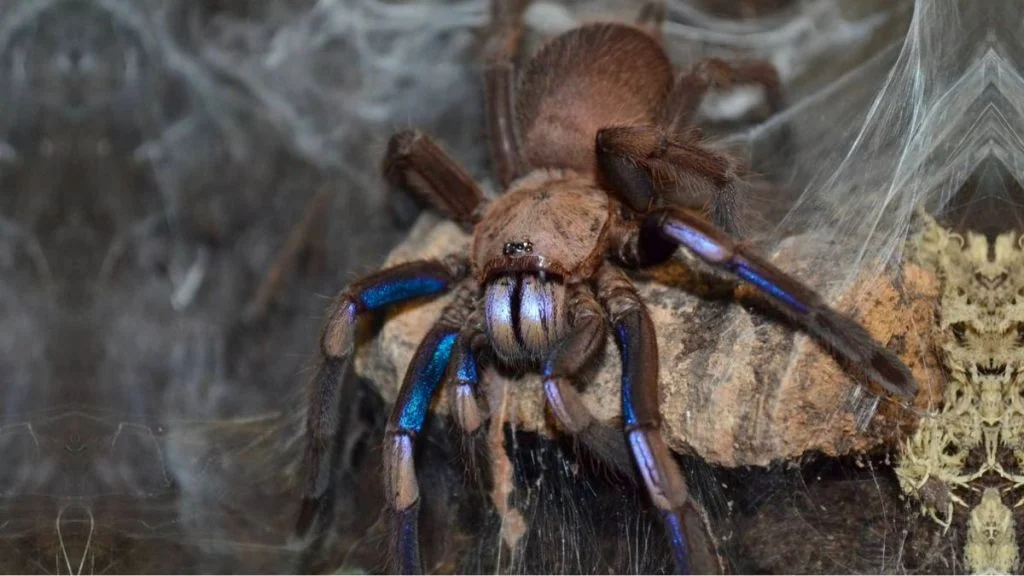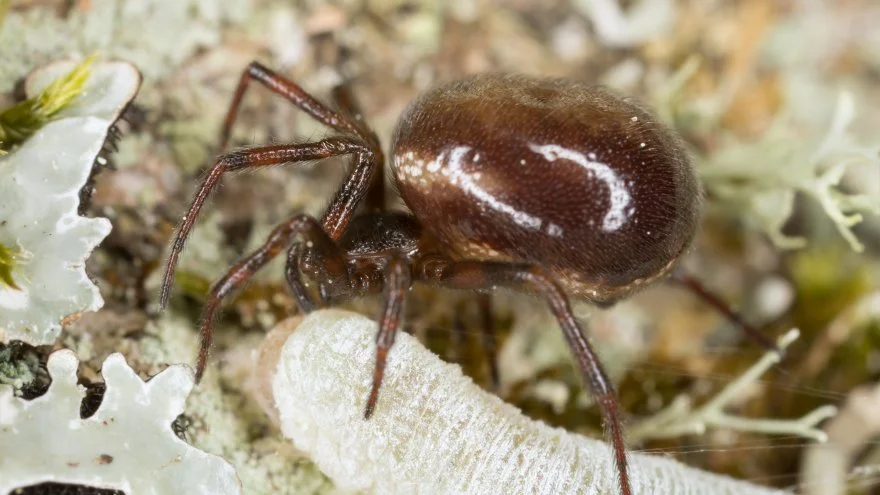The Chilobrachys sp. electric blue tarantula is commonly called the electric blue tarantula and is one of the species of the old world.
It got its name because of the stunning electric blue legs, and it is one of the exotic tarantula species in existence today.
Its appearance alone is enough to draw the attention of spider collectors, but what will make the experience worthwhile is knowing how to take care of it.
The electric blue tarantula requires an intermediate to a high level of experience. As a prospective owner, you should know the basics, such as its full appearance, behavior, and the differences between the male and the female. You should also know how to house and feed it.
The next section will explore everything you need to know about this Chilobrachys species.
Chilobrachys sp. Electric Blue Tarantula Care Sheet & Specifications

| Scientific Name | Chilobrachys dyscolus |
| Species Type | Old-world terrestrial |
| Family | Theraposidae |
| Natural Habitat | Forest |
| Range | Thailand, Vietnam |
| Growth Rate | Medium to fast |
| Adult Size | 5 to 6 inches |
| Lifespan | 3 years for males, 10 and 12 for females |
| Enclosure | Wide, tall, enough substrate and water |
| Temperature & Humidity | 75°F to 80°F temperature, 70% to 80% humidity |
| Diet | Carnivorous |
| Temperament | Can be aggressive and mean, doesn’t fight a lot but its venom is potent |
| Social | Solitary |
| Urticating Hair | No |
| Experience Level | Intermediate to advanced |
| Price | Spiderlings at $100, males at $150, females at $200 |
Appearance

The electric blue tarantula is a fanciful spider, and while members of the Chilobrachys genus are not exotic, this tarantula is a clear exemption.
Its first beauty is the blue legs (some members have purplish legs), which seem metallic and shiny. When it gets under light, the blue color gets more pronounced.
The carapace and abdomen are brown, which altogether makes the electric blue tarantula unique. Other than the blue color, this tarantula isn’t different from its fellow tarantulas in appearance.
In size, it is a small spider, with the adult not getting over 6 inches. The spiderlings are even smaller, but they grow fast.
If you get a spiderling, keep it in a big tank that can accommodate the adult size. It won’t take long before it grows.
Behavior
Tarantulas in general shouldn’t be handled, except when necessary. This rule applies even more to the electric blue tarantula.
This spider is neither calm nor shy, and though it doesn’t always fight it won’t hesitate to do so.
Its bite is also very painful, and even owners are not exempt. While it doesn’t have urticating hair, its fangs are dangerous.
The electric blue tarantula’s venom is also strong and leaves an effect on the victim, ranging from fevers to swelling and even chest pains.
This doesn’t mean the electric blue tarantula can’t be a good pet. While it isn’t the best spider for a beginner, someone with enough experience will find that the electric blue tarantula is amazing.
Its webs are as intriguing as its appearance, and it gives little issues with feeding. Once you can come to terms with its aggressive side, you’ll be fine.
The biggest letdown with the electric blue tarantula is its fossorial nature. It lives more in burrows and doesn’t come out as much as the owners would want. On the bright side, that makes it special.
Male vs Female
As a general rule amongst tarantulas, females have more advantages than males. We see the same pattern with the electric blue tarantula.
The female is bigger than the male for starters. It also has brighter blue colors as the male is more black than blue. The third difference is the same with many other animals: females can reproduce.
Then there’s the lifespan, which is the biggest advantage a female electric blue tarantula has over the male. We’ll look into that in the next section.
Lifespan and Health Issues
The male electric blue tarantula is expected to live only up to 3 years. On the other hand, the female lives up to 12 years, which is far more than the male.
Right after it gets to sexual maturity, the male doesn’t live longer than that. A reason for this could be the male’s high metabolism.
With a good enclosure and proper feeding, the electric blue tarantula rarely has any health challenges.
Dehydration and parasite/mite issues are the only major setbacks this spider can have, and they can easily be resolved.
That said, make sure its enclosure is wide and deep enough for it to form burrows.
Without burrows, the electric blue tarantula will not feel comfortable and may exhibit strange behaviors, including acting like an arboreal animal.
It needs a lot of damp substrates that can be material for forming burrows.
The final health consideration is the issue of molting/shedding, which many tarantulas struggle with.
While a lot of tarantulas can get rid of the molt without problems, sometimes they get stuck. Fortunately, you can learn how to help.
Electric Blue Tarantula Housing & Enclosure

The electric blue tarantula’s enclosure should reflect its natural habitat and meet its living needs.
You should put a lot of care and thought into the process so your pet spider can stay without feeling stressed.
One of the electric blue tarantula’s living needs is being able to make a burrow, and as we’ve seen, lack of that will lead to strange behaviors.
The enclosure has some special requirements, but it isn’t difficult to set up. Because of its fossorial nature, the enclosure should not be too tall and the focus should be on the ground.
The ideal enclosure should have enough room for it to move around without being too tall.
To make the enclosure feel like home, it needs some important items. A 6-inch substrate is one of those, and it should be able to retain moisture so the spider can build with it. Coconut fiber substrate can work.
Another needed item is a cork bark hide for shelter. This is highly important. Water in a bowl should be the last compulsory item for the spider to drink.
Besides these, let the enclosure be free for the electric blue tarantula to have webbing space. The temperature an electric blue tarantula can tolerate in the wild falls between 60°F in winter and 87°F in summer.
In an enclosure, the temperature range should be between 75°F to 80°F. If it goes lower than that due to weather changes, you should supplement the heat through safe means like a mild heat lamp.
The humidity should be between 70% and 80%. Keeping the substrate damp (not wet) is a good way to achieve this.
Diet and Feeding
The good thing about all tarantulas is that they can’t be overfed. The obvious challenge is that you need to keep them supplied with food.
The electric blue tarantula in particular needs a lot of food because it is active and uses up energy. It also has a voracious appetite and isn’t picky.
Some good insects for the electric blue tarantula are crickets, locusts, and roaches. Variety is the spice of life and even more for this spider. Some can even feed on little mice.
During the molting period, the electric blue tarantula often spends more time in its burrow and lowers its eating until it stops. It only resumes a week after molting.
Chilobrachys sp. Electric Blue Tarantula Price
This species of tarantula is relatively new, and early breedings started in 2016. As such, the price is on the high side compared to some other tarantulas.
Its beauty and activeness also contribute to the increase in demand and the high price. There’s room for reduction, though.
The electric blue tarantula spiderling started at $200 and is now at $100. We can hope to see it get cheaper over time.
For the moment, you should budget between $100 and $250. The price depends on both age and gender. The male adult is the cheapest while the female is the most expensive.
Also See:
Skeleton Tarantula Care Guide 101 (Ephebopus murinus)
Related Questions
Do tarantulas bond with their owners?
Tarantulas can detect when you’re around, especially if you’re the one giving it the food. However, they don’t bond with their owners, which is why handling should be kept at a minimum.
What is the most beautiful tarantula?
The most beautiful tarantula is the Socotra blue baboon tarantula. Its scientific name is the Monocentropus balfouri, and it is very colorful. It tops the list of beautiful tarantulas.
What is the meanest tarantula?
The meanest tarantula is the blue cobalt tarantula, which is considered one of the most aggressive tarantulas. Even spiderlings have been known to turn against their owners.
What is the safest tarantula to own?
Many tarantulas make safe pets, even for beginners. One such tarantula is the Mexican red knee and the Chilean rose tarantulas.
Final Thoughts
Is the electric blue tarantula a good fit for your spider collection?
The beauty of this old-world species might make you say yes, but you should look beyond that to know if you can cope with its aggressive tendencies, burrowing and specific needs.
It is often reserved for those with experience and is an amazing pet when well cared for.
Featured Image Credit: @insectmansion.germany / Instagram






